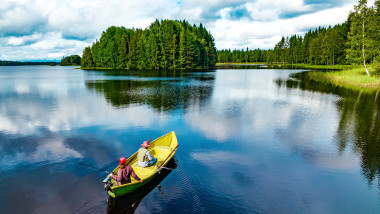Why Everyone's Talking About… Biodiversity
In fact, the loss of biodiversity and ecosystem collapse is one of the top three threats humanity is likely to face in the next 10 years.2 Over half the world’s total GDP is dependent on nature and is therefore at risk as a result of biodiversity loss.3
Mammal, bird, amphibian, reptile, and fish population sizes have shrunk by more than two-thirds since the 1970s.4 Most of us will have seen David Attenborough’s stark visual evidence of this and understand why it matters.5 However, recent studies suggest that the rate at which animals and plants are going extinct is getting worse than originally feared, largely due to human activity.
In April, for example, researchers found that more than 1 in 5 species of reptiles are now at risk of extinction as humans continue to take away their habitat for farming, urban development, and other industry6. Another study revealed that the combination of climate change and heavy agriculture is having a profound impact on the abundance and diversity of insects – in some areas, overall insect populations dropped by nearly half, with more than a quarter fewer species found7.
One of the big promises made at COP26 was to not only halt but reverse deforestation by the end of the decade. It’s a tall order when you consider that 11.1 million hectares of tree cover was lost in tropical rainforests in 2021, while primary rainforest – particularly important for carbon storage and biodiversity – was destroyed at a rate of ten football pitches every minute9.
Global Forest Watch, an initiative of the World Resources Institute with partners including the University of Maryland, estimates that this tropical forest loss released 2.5 billion tonnes of carbon emissions – on a par with India’s annual emissions7.
Likewise, oceans play a crucial environmental and socio-economic role for the planet – regulating climates, providing natural resources, enabling international trade, and ensuring livelihoods and food security for a large portion of the world’s population.
Coastal ecosystems such as seagrass, salt marshes and mangroves are also suffering. Kelp, coral and seagrass are “ecosystem engineers”11, building physical structures that create habitats for other life – coral reefs support over a million species, for example – and also provide food and protection to people.
Yet acidification caused by dissolved carbon dioxide will also affect a wide range of organisms, from fish to algae.
The oceans absorb about 30% of our emissions and their pH has fallen by 0.1 units since industrial times, making the water far more acidic. This, in turn, is pushing the Earth’s oceans toward a mass extinction event at a level not seen in about 250 million years, when scientists believe up to 90 percent of marine organisms went extinct due to overheated, acidic and deoxygenated oceans12.
Uncontrolled human activities are therefore putting the health of our oceans under threat, adversely affecting their biodiversity, their capacity to mitigate climate change, and putting at risk many communities’ sources of incomes and food. A disaster looms if we don’t act now.
Some 200 countries are expected to finally agree on steps to protect 30% of global biodiversity by 2030 – under terms expected to be finalised at the UN summit on biodiversity in Kunming, China, which is finally taking place in August 2022 after two years of delay. That’s certainly a start.
Part of the answer, however, may lie in understanding that biodiversity loss is inextricably linked with climate change – we can’t save plant and animal species without staying below 1.5 degrees Celsius, and vice versa. Indeed, the UN's Intergovernmental Panel on Climate Change (IPCC) warned that 9% of all the world's species will likely be "at high risk" of extinction even if warming is capped at the ambitious Paris target of 1.5 degrees Celsius14.
But we need to go further still and tackle the climate crisis, biodiversity loss and land degradation all at the same time – to echo the conclusions of the UN Convention to Combat Desertification (UNCCD) report8.
And while the focus on ‘nature’ and biodiversity is certainly rising up the corporate and ESG agenda, reported climate risks are still, on average, 10 times larger than water risks and 5 times larger than deforestation-linked risks. Just 1 in 20 companies have a science-based target for climate, a target for water withdrawals, and a best practice forests-related commitment that includes zero-deforestation15.
Encouragingly, the investor-backed Taskforce on Nature-related Financial Disclosures (TNFD) recently published first-of-its-kind guidance aimed at tackling the financial risks posed by nature loss16. And work is already underway to explore how we can translate nature-related risks into government action and investable ideas. What’s more, many ‘nature-based solutions’ are no longer considered the niche investment area they once used to be.
According one study, avoided deforestation could deliver more than 40% of total emissions reductions offered by ‘low-cost solutions’ – defined as solutions that would take less than $100 a year to reduce a ton of carbon dioxide emissions17. Brazil and Indonesia together contribute more than 50% of carbon emissions from tree cover loss across the tropics, and thus offer the greatest mitigation opportunity to avoid deforestation.
Between 2004 and 2012, Brazil reduced annual deforestation by 84% through a mixture of bolstered law enforcement, expanded protections and economic incentives, saving over 400 million tonnes of carbon dioxide a year18. Deforestation rates have unfortunately rebounded since the election of populist president Jair Bolsonaro – the fate of the Amazon rainforest may be decided by this year’s election – but Brazil’s success during its golden period shows what other countries with extensive rainforest cover could do.
Likewise, reforestation can work wonders. Take Costa Rica. In 1980, forest covered just 20% of the Central American country. It now carpets more than half, thanks largely to payments for reforestation and ecosystem preservation. Costa Rica’s land-use sector has moved from being a net emitter of carbon dioxide to a net absorber, to the tune of 3.5 million tonnes a year18.
Meanwhile, land use, such as agriculture and forestry, accounts for about a quarter of all carbon emissions19. To meet the 1.5% target, it needs to become a net carbon absorber by 2030. Therefore, giving farmers incentives to restore degraded pasture, plant trees and reduce fertiliser use are low-cost solutions that are appropriate for large swathes of the developing world.
Otherwise, the prospects are grim. In Morocco, for instance, 93% of the land is threatened by desertification, manifested by the partial or total loss of agricultural and grazing land, deforestation, and water imbalance. Unpredictable rainfall has been declining with unequal and irregular distribution for nearly a century, but overgrazing, deforestation and inappropriate agricultural practice are also to blame20.
In arid and semi-arid regions, agriculture exerts pressure on groundwater, so the implementation of sustainable agricultural practices and reasoned irrigation is therefore a crucial issue in dealing with the overexploitation of water resources and land degradation.
On the demand side, it certainly makes sense to encourage people to eat less meat. If everyone shifted to a plant-based diet, we would only need a quarter of the farmland used now, while vastly reducing the greenhouse gas emissions associated with producing food21.
There are also nature-based solutions that protect marine habitats and restore biodiversity to our oceans. Projects include supporting fisheries to maintain sustainable levels of marine fish stocks, providing financial incentives for low-impact aquaculture, responsible seafood supply chains, wastewater management, and more.
For example, in 2018, the World Bank helped the government of Seychelles issue the world’s first ‘blue bond’ – debt issued by governments, development banks or others to raise capital from investors to finance marine and ocean-based projects that have positive environmental, economic and climate benefits.
Seychelles is a small island nation, where fishing is the second largest sector behind tourism. The funding generated by the bond aims to help make the blue economy the Seychelles depends on more sustainable by both protecting marine biodiversity and financing the transition to a sustainable economy. The bond will provide grants for fisheries management activities and loans to encourage further investment in areas like post-harvest value adding opportunities and jobs in the protection of ocean resources22.
Our oceans’ combined assets can be valued at over $24 trillion when including their direct financial outputs, such as fisheries’ products, with indirect services like carbon sequestration and enabling international transport or tourism23. One study projects an additional $51 billion per year in profits could be derived from fisheries alone if sustainable fishing practices were implemented – a near 115% increase.24
Of course, we’ve only just dipped our toes into the topic of biodiversity. There are many more innovations that can finance nature-based solutions for oceans, forests, and agriculture – from green bonds to blended finance projects.
But the simple fact that ‘nature’ was part of the agenda at COP26 for the first time should be seen as a positive step forward. Now comes the hard part. Momentum must continue to COP27 and beyond if we are to come anywhere close to reaching our sustainability goals – let alone protecting and restoring the abundance of our planet’s species.
- Greenhouse gas (GHG) emissions – these include carbon dioxide (CO2), which enters the atmosphere through, for example, burning fossil fuels (coal, natural gas, and oil); methane (CH4), which is emitted during the production and transport of fossil fuels, for example, and from livestock and other agricultural practices; Nitrous oxide (N2O), which is emitted during, for instance, agricultural, land use, and industrial activities, as well as during treatment of wastewater; and fluorinated gases – synthetic, powerful greenhouse gases that are emitted from a variety of household, commercial, and industrial applications and processes.
- Taskforce on Nature-related Financial Disclosures (TNFD) – launched in June 2021 to emulate the relative success of the Financial Stability Board’s climate-related taskforce (TCFD), which was created to improve and increase reporting of climate-related financial information, the TNFD is backed by Global Canopy, the UN Development Programme, the UN Environment Programme Finance Initiative and the World Wide Fund for Nature. The proposed disclosure framework addresses previous concerns raised by investors that existing shortcomings in biodiversity-related data from corporates have hindered progress in mitigating these risks and impacts. The final version of the TNFD’s recommendations is due in September 2023.
- Nature-based solutions (NBS) – defined by the International Union for Conservation of Nature (IUCN) as "actions to sustainably protect, manage and restore natural or modified ecosystems, which address the challenges in an effective and appropriate manner, simultaneously delivering benefits for human well-being and biodiversity”.
2 Source: World Economic Forum’s 2022 Global Risks Report, https://www3.weforum.org/docs/WEF_The_Global_Risks_Report_2022.pdf
3 Source: World Economic Forum’s 2020 New Nature Economy Report, https://www.weforum.org/reports/new-nature-economy-report-series
4 Source: WWF, The Living Planet Report 2020, https://wwf.panda.org/wwf_news/?793831/WWF-LPR--reveals-two-thirds-decline-in-wildlife-populations-on-average-since-1970
5 Source: BBC, Extinction: The Facts, 2020, https://www.bbc.co.uk/programmes/m000mn4n
6 Source: New York Times, April 2022, https://www.nytimes.com/2022/04/27/climate/reptiles-extinction-biodiversity.html
7 Source: Nature, April 2022, https://www.nature.com/articles/s41586-022-04644-x
8 Source: United Nations Convention to Combat Desertification, Global Land Outlook 2022, https://www.unccd.int/resources/global-land-outlook/overview
9 Source: Global Forest Watch, April 2022, research, https://globalforestwatch.org/blog/data-and-research/global-tree-cover-loss-data-2021/
10 Source: Climate change: A status report, New Scientist, April 2021, https://www.sciencedirect.com/science/article/abs/pii/S026240792100703X
11 Source: Bridging the gap between coastal engineering and nature conservation, Philipp Jordan & Peter Fröhle, Journal of Coastal Conservation, February 2022, https://link.springer.com/article/10.1007/s11852-021-00848-x
12 Source: Science, April 2022, https://www.science.org/doi/10.1126/science.abe9039
13 Source: France24, March 2022, https://www.france24.com/en/live-news/20220314-un-launches-biodiversity-talks-on-deal-to-protect-nature
14 Source: Carbon Brief, February 2022, https://www.carbonbrief.org/in-depth-qa-the-ipccs-sixth-assessment-on-how-climate-change-impacts-the-world/
15 Source: Now for nature, Oliver Wyman, 2022, https://www.oliverwyman.com/content/dam/oliver-wyman/Now%20for%20Nature_report_2022.pdf
16 Source: TNFD news, March 2022, https://tnfd.global/news/feb-mar-newsletter-first-beta-version-of-tnfd-framework-for-market-consultation/
17 Source: Natural climate solutions, PNAS, October 2017, https://www.pnas.org/doi/10.1073/pnas.1710465114
18 Source: The potential of scaling up proven low-carbon solutions, Ecofys/ Sitra, 2015, https://www.sitra.fi/app/uploads/2017/02/Ecofys_2015_potential_of_scaling_up-low_carbon_solutions.pdf
19 Source: IPCC, August 2019, https://www.ipcc.ch/2019/08/08/land-is-a-critical-resource_srccl/
20 Source: Desertification Assessment Using MEDALUS Model in Watershed Oued El Maleh, Morocco, July 2017, https://www.mdpi.com/2076-3263/7/3/50/htm
21 Source: Our World in Data, https://ourworldindata.org/land-use-diets
22 Source: The Little Book of Investing in Nature, Global canopy, 2021, https://globalcanopy.org/wp-content/uploads/2021/01/LBIN_2020_EN.pdf
23 Source: WWF, April 2015, https://wwf.panda.org/wwf_news/?244770/Ocean-wealth-valued-at-US24-trillion-but-sinking-fast
24 Source: Rebuilding the world’s fisheries, Environmental Defense Fund, 2015, https://fisherysolutionscenter.edf.org/sites/default/files/Rebuilding%20the%20World%27s%20Fisheries.pdf
* CFA® and Chartered Financial Analyst® are registered trademarks owned by the CFA Institute.
** Mirova is operated in the US through Mirova US LLC (Mirova US). Prior to April 1, 2019, Mirova operated through Ostrum US.
This material is provided for informational purposes only and should not be construed as investment advice. Views expressed in this article as of the date indicated are subject to change and there can be no assurance that developments will transpire as may be forecasted in this article.




 Why Everyone's Talking About… The Quantum Apocalypse
Why Everyone's Talking About… The Quantum Apocalypse
 Why Everyone's Talking About… The Metaverse
Why Everyone's Talking About… The Metaverse
 All back to bonds?
All back to bonds?
 Mirova B(ey)ond Green - Sustainable bond investments: What's new?
Mirova B(ey)ond Green - Sustainable bond investments: What's new?